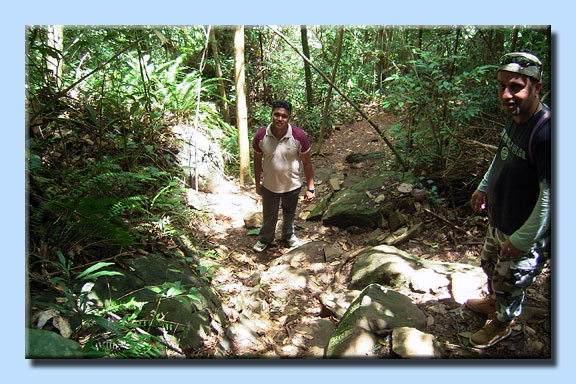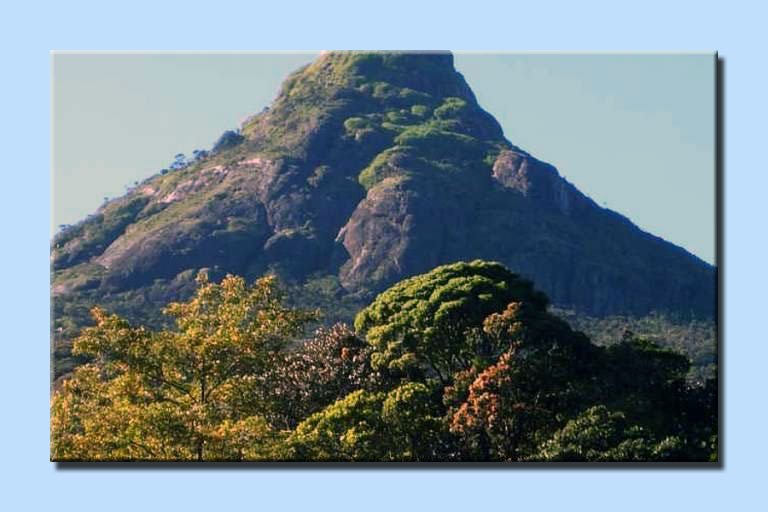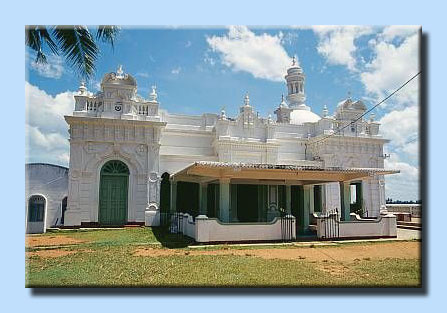

| |
| Start |
| Philosophy and History |
| Guesthouses |
| Gallery |
| Information for your trip |
| About us |
| Imprint Terms and Disclaimer |
| Links |
| Booking and Contact |
| Guestbook |
| Excursions |
| 1. 2. 3. 4. 5. |
|
The Singharaja Rainforest Reserve is a 'must see' for every Hobby-ornithologist and for nature lovers. It is one of the few parks in Sri Lanka where visitors are allowed to walk. Singharaja-which translates as `Lion King`-covers an area of approximately 20000 hectares and consists of jungle and imported plants, such as Burma teak. From the commercial logging the British began in the colonial times, it took until 1977 that the exploitation of the forest has been changed to save the unique nature Singharajas for future generations. The journey from Colombo to Singharaja takes approximately 4 hours and leads through a stunning mountain landscape Singharaja can be entered by different ways. Kudawa in the Northwest is the main entrance. Access is only possible with a permit, which is issued by the Forest Department(Forest Service) 82 Rajamalwatte Road, Battaramulla. Birds are the highlight of the park in Singharaja. There are 22 of 25 from the critically endangered species in Sri Lanka to be observed. Even inexperienced bird watchers can hope to observe 10 to 15 endangered species during their stay. Not only the birds make the stay in the park so interesting. A large variety of trees and flowering plants and numerous colorful butterflies tumble on the forest floor. Due to the very dense wood it is difficult to watch wild animals, but the visitor has a good chance to observe a giant squirrel (Petaurista petaurista), mongooses (Mungos mungo), Red langur (Presbytis melalophos, wild boar(Sus scrofa) and Java Muntjak(Muntiacus muntiacus). To catch sight of a rarer species such as rust cat (Phantera pardus), fish cat (Felis viverrina), Zibetcat (Civettictis Civetta) and leopard (Panthera pardus), you need a bit of luck and patience. (Do not forget binoculars) The mountain of Butterflies. The uniform triangle of Adam's Peak in Sri Lanka exerts a magical attraction for believers of all religions-and once a year to millions of old and weak insects. They come from all corners of the island, like a magnet in the mountainous region in southwest of Sri Lanka draws them near. They cross over teaplantations, on which the saris of the pickers emerge like colorful paintspots, passing thundering waterfalls and foggy valleys. You leave the woods behind you, where leopards, wild boars and jackals lurk, to finally reach the slopes of a distinctive, triangular hill. Here, where high on the summit a sacred footprint adorns the rock, they die-the swarms of small yellow butterflies. Or, as the Buddhist believes, reincarnate in to another form of life. The hustle and bustle is called Samanalayo, after Samanola, the old Vedic name of the mountain. There is no scientific explanation for the annual butterfly flight, which lasts only a short time. The timing, however, is always in the pilgrimage season, bewtween the full moon of December and the full moon of May, which is the day of Buddhas birth. But the 2,234 meters high Adam's peak is also a unique attraction to human visitors. For all four major religions of Sri Lanka the holy mountain is an important pilgrimage destination. For the buddhist, approximately 70 percent of the population, it is the Sri Pada, where Buddha during his third and final visit to the island has left his footprint. The Hindus call the mountain Shivan Adi Patham, 'Creation Dance of Shiva'. They believe that the god Shiva embossed the rock when he created the world dancing. The muslims believe it is a trail from the prophet Adam. To limited the horrors of expulsion from paradies God choose a place for Adam that came closes to the Garden of Eden - Adam's Peak. The Christians recognize the footprint of St.Thomas the Apostle, who brought the Christianity 50 AC to South India. For centuries, pilgrims of all four confessions climbed the peak, which can be seen from the far sea in clear weather. Even the rulers of the ancient kingdoms of Anuradhapura and Pollonaruwa constructed shelters on this sanctuary place. At this time it was a dangerous pilgrimage through dense forests with wildlife, deep ravines and steep slippery slopes. Some pilgrims made the journey on the back of an elephant and then in a sedan chair borne by slaves before they climbed the last troublesome section on chains and poles to reach the holy footprint - like the Arab traveler Ibn Battuta in the 14th century 'eleven hand-long margins'. While the earlier pilgrims had to find their way in the flickering light of a torch, today they follow a zigzag path of with electric lights up the hill, until they almost form a vertical line to the peak. The pilgrims owe this light to a minister that made a vow over 50 years ago. He had the lights installed after a dam has been completed before the estimated time. Most island visitors choose the shortest possible walking routes - the seven kilometers long way that is still exhausting which starts at the beginning of the tea plantation of Dalhousie. You leave the bustle of the tea shops and stalls behind you where zealous merchants offer warming caps, Indian sweets, rice and lentil pancakes, painkillers and sacraficial offerings. After a short time they reach a ritual bathing resort. Here, pilgrims wash themselves in the frigid mountain water or even brush their teeth before they step through a large gate. Again and again we see little memorials with statues, that represent Buddha or the Hindu elephant god Ganesha. The shrines are often decorated with stripes of white cloth - pilgrims tied them there as a sign of prayer or thanksgiving. Despite the frosty night air, many pilgrims were poorly dressed, the only concession they made to the cold is often a white cloth draped around the head and shoulders. The road is rapidly painstaking and only about 4 hours or 5000 steps later they reached the summit- the elderly and small children, frail and weak, hole families strengthened by their faith. Again and again you hear pilgrims who recite religious verses and say the greeting `Karunavai`- peace. Along the route private providers , voluntary organizations and the Buddhist Temple Trust, which administers the holy site, set up rest stops. Weary pilgrims can maintain their aching muscles with ayurvedic balm or slurp a cup of hot tee with milk. Some travellers surprisedly observe that Buddhist pilgrims cast a threaded needle at a certain position into the bushes- according to the legend Buddha rested here to mend a tear in his robe. About half way the pilgrims clean and freshen in the river Seetha Gangula for the last stages. Shortly before the summit, where the stairs built a nearly vertical ladder, they have to wait up to half an hour in high season. Then finally the destination is reached. Faithful fervently pray to the holy footprint which is enclosed by a temple. Visible is just an oversized replica of the original rock that covers the footprint. After the prayer the pilgrims ringing a bell- just once for each visit. Often you hear the bell a dozen times or more as a sign of pious pilgrims who repeatedly come to the sanctuary. All those who reach the summit before sunrise can expect a special award for religious merrit: When the daylight slowly discolores the sky, the black night turns in pale gold, deep orange transforms in fiery red, a magic mountain panaroma peels out of the darkness. Then, quite suddenly and for only a short time, you can see: The strong, evenly triangular shadow of the sacred mountain slides in the risring sun on the endless wooded hills- a unique natural spectacle, probably staged by the gods themselves. A Sri Lankan landscape architect named Bevis Bawa, that died at high age in 1992, created the magical property in the period from 1929. On my first trip with a Tuk Tuk there was a lot to see along the way already. I observed a kingfisher and many cranes in a marshy area, and right next to me a waran slipped quietly into the water. A chameleon sat on a branch and in your imagination you could see the illustrious guests that have visited the property and walked through the garden. In the house are quite a lot of photos of the famous guests who were visiting here. I remember Wallis Simpson and her husband , who abandoned the english throne for her, the former king of Norway and other illustrious figures.. Go there and let the Brief Garden affect you... The oldest Islamic house of God in Sri Lanka is situated on a peninsula at Beruwala. From its terrace you will have a fantastic view at one of the many dream coves of the south-west coast. The mosque was probably built in the 13th century. At this point( according to other sources in the 8th century) Arab traders founded a municipality under the banner of the Prophet. Beruwala kept its Muslim character up to this very day. At the harbour next to the old mosque you can watch a fascinating and quite bloody spectacle every morning. In the sand they cut swordfish and barracuda and sometimes unfortunate small whales. If you like it more gentle you can take a boat tour to the lighthouse that thrones on a rock by the coast. The trip will cost only a few rupees (around 1,50 euro), but from the top of the tower you can take the best pictures of the mosque, Harbor and Palm Coast. |


